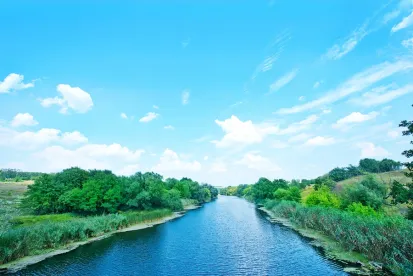On Friday, the National Oceanic and Atmospheric Administration (NOAA Fisheries) issued two proposed rules designating critical habitat for the Atlantic sturgeon.1 The proposed rules cover most major river systems along the Eastern Seaboard, including the Hudson, Delaware, and Susquehanna river basins, Chesapeake Bay, and other waterways throughout the country’s most populated region. Atlantic sturgeon have been protected under the federal Endangered Species Act (ESA) since 2012.
The proposed critical habitat includes 945 miles of aquatic habitat in rivers from Maine to the Chesapeake Bay system and 3,309 miles of river habitat in the Carolinas, Georgia, and Florida. Activities potentially affected by the critical habitat designation include any that adversely modify river substrate, impede passage, change salinity, change depth, add nutrients, increase temperature, or increase sedimentation. By way of example, such activities could include in-water construction; dredging; bridge, culvert, and road projects; hydropower projects; utility lines; sand and gravel mining; and activities requiring Clean Water Act Section 402 permits.
Designation of critical habitat does not create preserves or refuges. However, when a federal agency is carrying out, funding, or authorizing an activity that may affect the critical habitat, such as those activities listed above, the federal agency is required to consult with NOAA Fisheries to avoid or minimize potential impacts to the species’ habitat. The activity of the federal agency, including permit terms and conditions, may need to be modified to avoid destroying or adversely modifying the critical habitat. Many businesses, governments, special-purpose districts, water users, energy and transportation infrastructure developers, permit holders, landowners, and others are potentially affected by designation of critical habitat for the Atlantic sturgeon.
The period for public comment on the proposed rules ends on September 1, 2016. The proposed rules include schedules for public meetings and hearings at various sites along the East Coast from the latter half of June through late July.
The public comment process is the key opportunity to advise NOAA Fisheries on what areas should and should not be considered critical habitat and to provide supporting information for the administrative record before the agency. This is a crucial phase in the procedural process, particularly for any party anticipating litigation on the issue, because there is little opportunity to develop the record once it is before the court. The court will generally address any challenge to the designation based on its review of the administrative record compiled before the agency during the designation process.
Potentially affected parties may want to consider providing information to NOAA Fisheries to aid the agency in identifying which areas contain or lack the primary constituent elements essential to the conservation of the species, as areas lacking such elements do not meet the regulatory definition of critical habitat. In addition, the ESA specifically directs the agency to take into account the economic and other impacts of designating particular areas as critical habitat and provides NOAA Fisheries with the opportunity to exclude areas from a critical habitat designation based on economic considerations.
Potentially affected parties will want to examine closely the economic analysis included in the proposed rule, noting its assertion that there will be no incremental costs incurred in the form of project modifications due to designation of critical habitat, while acknowledging that the agency is unable to predict the location and magnitude of project modifications that may result from Section 7 consultations.2 Also, parties who are participating in a habitat conservation plan (HCP) under ESA Section 10 may have a basis to exclude areas covered by the HCP from the designation.
If NOAA Fisheries develops an overbroad designation, litigation may provide a remedy in appropriate instances, though the courts have been reluctant to overturn agency critical habitat decisions. In 2013, a federal district court in Alaska overturned the U.S. Fish and Wildlife Service’s designation of critical habitat for the polar bear after it determined that the agency failed to follow the required procedures, failed to appropriately consider and respond to the State’s comments on the designation, and failed to document that all areas designated contained the necessary primary constituent elements to support the designation.3 Earlier this year, however, the Ninth Circuit reversed the district court, finding that the agency did not act arbitrarily or capriciously in designating critical habitat for the species because it drew rational conclusions from the best available scientific data, as is required by the ESA.4
ESA Section 4 also contains specific petition procedures that, in applicable circumstances, can be used to revise or correct an overreaching designation. In Idaho, NOAA Fisheries revised the critical habitat designation for Snake River chinook salmon through this procedure after a petitioner established that an area did not satisfy the requirements to be treated as critical habitat.5 These and other approaches to managing critical habitat issues may merit consideration in responding to the Atlantic sturgeon proposed critical habitat designation.
1 NOAA Fisheries’ proposed rule covering Atlantic sturgeon populations in the area from Maine to the Chesapeake Bay is published at 81 Fed. Reg. 35701. The proposed rule covering Atlantic sturgeon populations in the Carolinas, Georgia, and Florida is published at 81 Fed. Reg. 36078. Supplemental materials, including the draft economic analysis for the Maine-Chesapeake habitat proposal, are posted here.
2 National Marine Fisheries Service, Designation of Critical Habitat for the Gulf of Maine, New York Bight, and Chesapeake Bay Distinct Population Segments of Atlantic Sturgeon, 25-26, available at http://www.greateratlantic.fisheries.noaa.gov/protected/atlsturgeon/docs/draft_biological_information_and_esa_section_4_b__2__source_document_with_irfa_and_econ_anal.pdf.
3 Alaska Oil & Gas Ass’n v. Salazar, 916 F. Supp. 2d 974 (D. Alaska 2013).
4Alaska Oil & Gas Ass’n v. Jewell, 815 F.3d 544 (9th Cir. 2016).
5See Designated Critical Habitat: Revision of Critical Habitat for Snake River Spring/Summer Chinook Salmon, 64 Fed. Reg. 57399 (Oct. 25, 1999).




 />i
/>i

